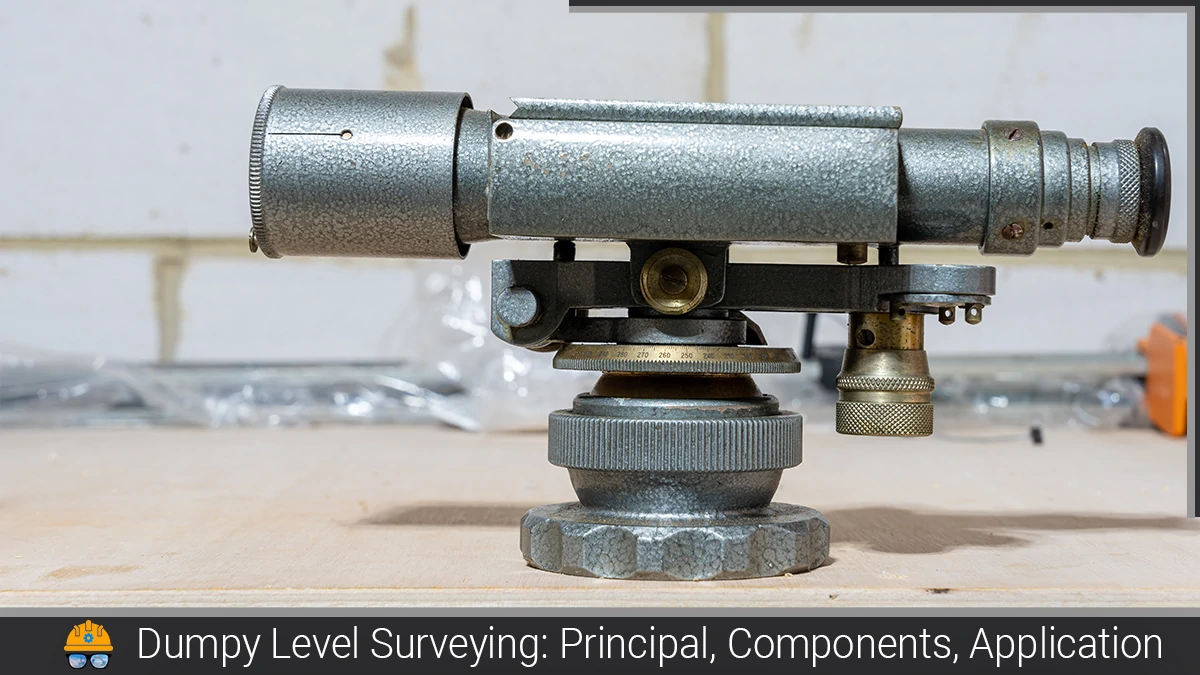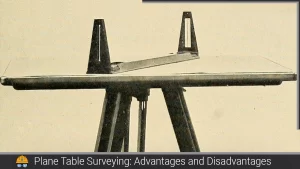Introduction
Chain surveying is a method of linear measurement of the distance. It is also called Changing. The changing is a method of measuring the linear distance with a tap or chain. Chaining is known to be the most accurate method of direct linear measurement. However, for more precision work a measuring tape is preferred over the chain. Chain is used for ordinary works of measurement.
An instrument for chaining:
The following instruments are used for chaining or chain surveying:
- Chain
- Tap
- Arrows or marking pins
- Pegs
- Ranging rod
- Offset rod
- Plasterers’ laths and whites
- Plumb bob
1. Chain
Chains are made of galvanized mild steel rings or oval wired rings connected to form a line of chain. Three rings or oval-wired rings are connected at either side to form a chain and are kept flexible. The chain is provided with a brass handle at the two ends and swivel joints so that it does not get twisted. The measurement is taken from the outer end of the handle to the other outer ends of the other handle.
Types of Chain Surveying
The following are the other types of chains used:
- Metric chains
- Steel band or Band chain
- Gunter’s chain or surveyor’s chain
- Engineer’s chain
- Revenue chain
1. Metric chain
After the introduction of the metric system, the metric chain is the most commonly used instrument in India. Metric chains are usually available as 5m, 10m, 20m and so on. The requirement of the Matric chain is given in IS 4592-1970.


The reading of the chain is eased by fixing the tallies at every 1m for the chain length of 5 to 10m as shown in fig.-1, and every 5m for the chain length of 20 to 30m as shown in fig.-2 and fig.-3. The shape of the tallies is shown in fig.-4.



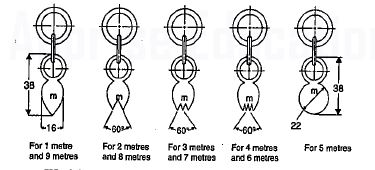
2. Steel band or Band chain
A steel band is a long narrow strip of blue-coloured steel with a width of 12 to 16mm and a thickness of 0.3 to 0.6mm. Metric steel band are usually available in 20 to 30m and it is divided by brass studs every 20cm. The first and last 20cm is further divided into cm and mm.
3. Gunter’s chain or surveyor’s chain
A Gunter’s chain or surveyor’s chain is a chain 66 ft. long and consists of 100 links. Each link is 0.6 ft. or 7.92 inches long. The length of 66 ft. was originally adopted as it is convenient for land measurement. Since 10 square chains are equal to I acre. Also. when linear distance measurements are required in furlongs and miles, it is more convenient with Gunter’s chain, as 10 Gunter’s chains = 1 furlong and 80 Gunter’s chains = 1 mile.
4. Engineer’s Chain
An engineer’s chain is 100 ft. long and consists of 100 links. Each link is equal to 1 ft. long. At every 10 links, brass tags are fastened with notches on the tags indicating the number of 10 link segments between the tag and the end of the chain. Thus the distance measured is in feet and decimals.
5. Revenue chain
The Revenue chain is. 33 ft. long and it consists of 16 links and each link is 2 1/16ft. long. This chain is mainly used for measuring fields in cadastral surveying.
2. Tapes
This instrument is used for more accurate measurement works. Tapes are classified depending upon the materials they are made of as follows:
- Cloths or linen tape
- Steel tape
- Metallic tape
- Invar tape
Also, read: Distance Measurement With Measuring Tape: Corrections & Errors
3. Arrows or marking pins
Arrows or marking pins are made of steel wire and it is generally provided in 10 numbers with the chain. An arrow is made of Arrows or marking pins made of steel wire and it is generally provided in 10 numbers with the chain. An arrow is made of hardened and tempered steel of 4mm (8SWG) in diameter. The length of the arrow varies from 25cm to 50cm and is painted with black enamel paint. One end of the arrow is sharp and pointed and the other end is made into a loop or circle which enables carrying. 40cm long is the most common and is recommended by Indian Standard. An arrow is inserted in the ground at every chain length as measured on the ground. The fig.-6. shows the recommended arrow length.

Also, read: Theodolite Surveying: 2 Types of Adjustments and Errors
4. Pegs
Pegs are usually made of wood and stout timber is chosen for it. Usually, 15cm long and size 2.5 to 3cm the Pegs are usually made of wood and stout timber chosen of it. Usually 15cm long and size of 2.5 to 3cm in with the tapering at one end. Pegs are used for marking the stations or terminal points of the survey line. They are driven into the ground by the wooden hammer or mallet and kept 4cm projected above the ground.
5. Ranging Rods
Ranging rods are usually 2 to 3m in length and come with a heavy iron part at the lower end. The common type of ranging rods is 2m long. Ranging rods are painted with alternating bands of black and white or red and white or black. Each band measures 20cm and can occasionally be used for rough measuring for shorter lengths. Ranging rods are either circular or octagonal in cross-sectional with a nominal diameter of 3cm.
Ranging rods are used to range intermediate points in survey lines and they appear to be invisible at a distance of 200m. Thus, when used in the long survey line the rod should have either a red, yellow or white flag. The flag should measure 30 to 50 cm in square and be tied at the near end of the top.
Ranging poles are similar to ranging rods but come with a longer length and greater diameter. They are used to establish two terminal points in a line before initiating the change. The process of establishing or fixing is known as “ranging” and there are of two methods of ranging.
- Direct method
- Indirect method
6. Offset Rods
An offset rod is similar to a ranging rod and is of length 3 m. They are round wooden rods, with a pointed iron end, and provided with a notch or a hook at the other end. The hook is used to facilitate pulling and pushing the chain through obstructions like hedges. The primary function of the rod is to mainly measure rough offsets nearby. The rod comes with two narrow slots passing through the centre of the section and set at right angles to one another side at the eye level for aligning the offset line.
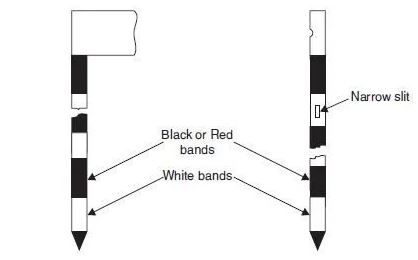
7. Plasterers’ laths and whites
Plasterer’s lath:- This is usually made of softwood measuring up to 0.5m or 1m in length. They are painted a light colour and light in weight which is easily carried and sharpened with a knife as and when required. They are used to line out an intermediate point in open ground. Also, used for ranging out lines when crossing depression and passing the obstacle offered by hedges, etc. when the forward line becomes invisible..
Whites:- They serve the same purpose as the lath and are a piece of sharpened sticks with cuts at the end (fig.-8.). However, they are not satisfactory for the use of lath. The cut and split portion of the end (upper portion) is used to support the white paper which offers better visibility in the ground or grass. They are also used in cross-sections or temporary marking of the counterpoints.

8. Plumb Bob
A plumb bob is an instrument with a lot of applications in the field of engineering and surveying. The plumb bob in chain surveying is used to transfer the point to the ground when chaining along the sloping ground. It is also used to make a ranging rod vertically and transfer the point from a liner ranger to the ground. Traditionally it is used as an aid for centring theodolite, compass, plane table and much other surveying equipment.
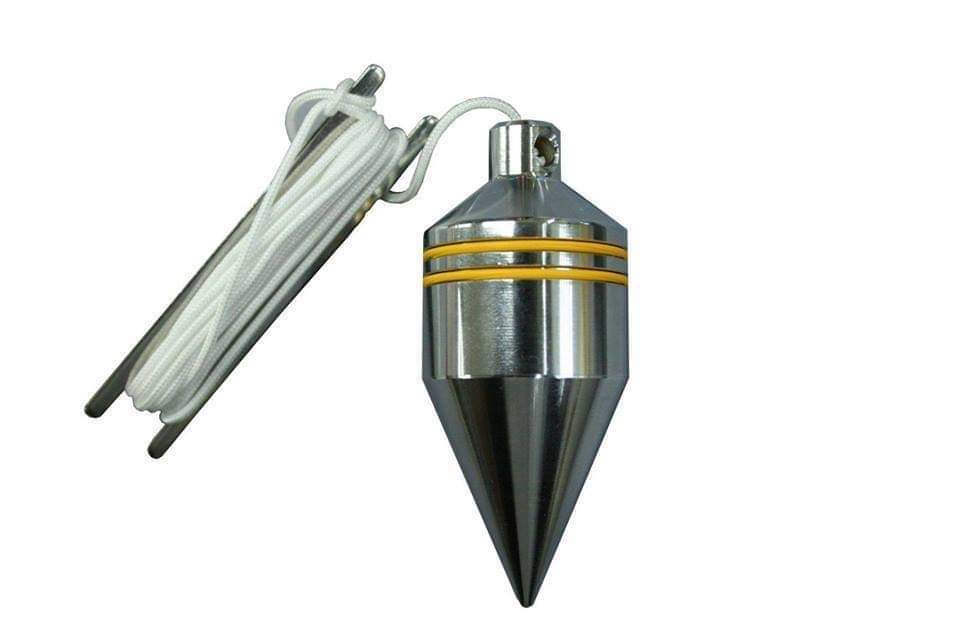
Also, read: Dumpy level Surveying: Principal, Components and Application
FAQs:
Q: What is Chain Surveying?
A: Chain surveying is one of the earlier methods of surveying which involves the linear measurement of the distance with the help of a specific chain. This method is also called Changing. The changing is a method of measuring the linear distance with a tap or chain. Chaining is known to be the most accurate method of direct linear measurement. However, for more precision works a tap is preferred over the chain. Chain is used for ordinary works of measurement.
Q: What is an Engineer’s chain?
A: An engineer’s chain is a chain used in chain surveys that measure up to 100 feet long and it consists of 100 links. Each link is equal to 1 ft. long. At every 10 links, brass tags are fastened with notches on the tags indicating the number of 10 link segments between the tag and the end of the chain. Thus the distance measured is in feet and decimals.
Q: What is an Offset rod?
A: An offset rod is similar to a ranging rod and has a length of 3 m which is one of the instruments used in chain surveying. They are round wooden rods, with a pointed iron end, and provided with a notch or a hook at the other end. The hook is used to facilitate pulling and pushing the chain through obstructions like hedges.
The primary function of the rod is to mainly measure rough offsets nearby. The rod comes with two narrow slots passing through the centre of the section and set at right angles to one another side at the eye level for aligning the offset line.
References:
- Punima, B. C., Jain, A. K., & Jain, A. K. (2024). Surveying: Vol. I (18th ed.). Laxmi Publications (P) Ltd. https://www.laxmipublications.com/servlet/lpgetbiblio?bno=000713&pageName=Keywords
- Arora, K. R. (2018). Surveying: Vol. I (17th ed.). Standard Book House U-0., Rajsons Publications Pvt Ltd. https://www.standardbookhouse.online/product-page/surveying-vol-i-si-units-low-price-a-4-size
![]()






